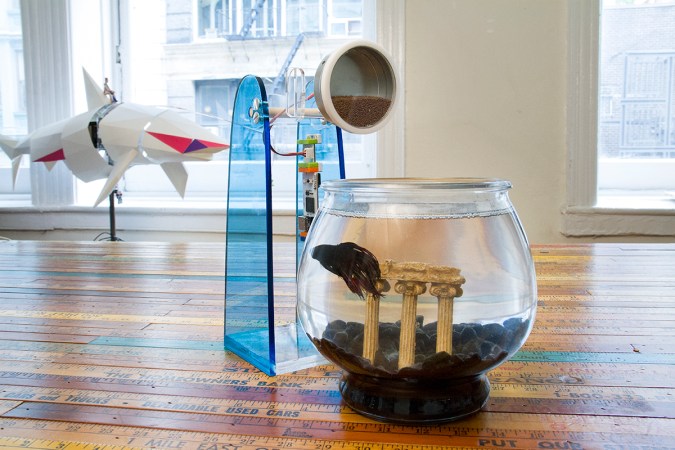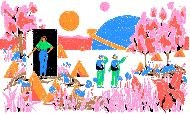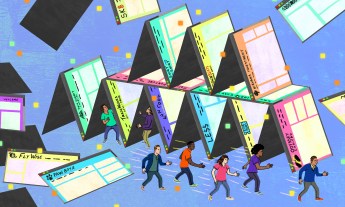
littleBits founder Ayah Bdeir wants you to snap the internet to anything you want.
How might the Internet of Things make the world a better place? To find out, we asked TED Fellow Ayah Bdeir, an engineer, artist and founder of the modular electronic circuit toy-slash-tool littleBits. (Watch her TED Talk, “Building blocks that blink, beep and teach.”) Below, Bdeir explains IoT, cloudBit, and how to ensure that IoT technology is available to everyone.
What is the Internet of Things, in a nutshell?
The Internet of Things is a buzzword at the moment. Essentially it means that the internet is coming off our computers, phones, and other electronic devices, and starting to live in the objects around us. It can be embedded in anything, from a fridge to a thermostat to a chair to a table to traffic lights.
I believe there’s huge potential for social change through the Internet of Things – if we democratize the technology, so it becomes hackable by regular people.
Some of the very early research comes from Neil Gershenfeld from the MIT Media Lab. He called it Internet 0, and his concept explored how our objects communicate with us, how we communicate with them, and how can they sometimes communicate with each other, so that we can have better control of our lives.
Traffic lights already talk to each other, so is IoT just a matter of making the communication between objects available on a consumer level?
It’s more about gathering intelligence with a variety of different systems. So while traffic lights do currently communicate with light controllers, they don’t yet communicate with approaching cars, for example. But what if traffic lights could tell the car ahead of time that there’s a string of traffic lights coming on, and so the car should take another direction?
At the consumer level, it might be something like making homes smarter and more efficient — networking your air-conditioning, oven and porch light so that you can text them to come on on your way home, for example.
Above: The littleBits Remote Pet Feeder.
At an industry level, every large company dabbling in consumer electronics has become fascinated with and invested in the Internet of Things. Samsung, Apple, Intel — Cisco calls it the Internet of Everything, while GE calls it the Industrial Internet.
WHy should the Internet of Things remain in the hands of engineers?
These companies are all approaching the concept in one of two ways. The first is as a utility — kind of like electricity. In this analogy, you’d have to make a deal with a central company, which has control over the grid and charges a subscription. You buy into their infrastructure, and that’s how your objects will communicate with each other. The problem with this model is that it’s imposing a top-down perspective — and we know those models are antiquated.
The second approach is creating closed, hyper-prescribed devices that have a certain functionality, and claiming they’ll make life easier — such as a thermostat that responds to your phone, or a garage door that is opened by texting. Companies are coming up with specific solutions to specific problems. But these closed devices will prescribe behavior, and box us in even further. You can’t customize them the way you want.
That’s why I believe in open platforms. We want to make the Internet of Things an open platform for anyone to create what they want. You can make your own Sonos, or your own Nest — or the next big thing.
I can see how it’d be fun to make a gadget for feeding fish or watering a plant remotely, but what promise does the Internet of Things hold for seriously meaningful innovation?
I believe there’s huge potential for social change, for economic change and for political change through the Internet of Things – on the condition that we democratize the technology, so it becomes hackable by regular people.
If the Internet of Things remains in the hands of large topologies and engineers — well, engineers may not be the ones who will come up with the most meaningful human and world-changing applications. On the other hand, people on the ground in developing countries, people who are face-to-face with problems that really need to be solved — they will see new solutions.
Above: Grandma’s Pill Box: a littleBits powered system to help seniors remember to take their medicine.
For example, the Internet of Things might help people who want to do citizen data science. They might want to put a bunch of sensors in a field and monitor air quality, soil quality. You could use littleBits and cloudBits to start to gather that data, since it might not be appropriate to use a smartphone in the field. There is still a barrier — the Internet of Things requires the internet and power. Having said that, I think it’s safe to assume that we’re on the path of the entire world being internet connected. It hasn’t happened yet, but it’s happening.
How does cloudBits work?
Essentially, a cloudBit is a wifi-connected Bit. As with all littleBits modules, it’s small, cute, and unintimidating. But it’s incredibly powerful. Within a minute, you’re able to set it up and attach it to your wifi, and suddenly you can control it with your phone, you can have it read information from the internet, you can control it with this service called IFTTT, which can hook it up to Facebook and Twitter and email. Suddenly you can connect anything to the internet.
So we call it “Snap the Internet to Anything.” The chair I’m sitting on — I can snap a cloudBit to it, and a pressure sensor, so that every time I sit on it, it sends a tweet to someone that says “Ayah sat.” Why you’d want to do that, I don’t know, but if 1,000 people did it, you might start to see data patterns. One maker in our community made an umbrella notification system. It’s a little bucket with an umbrella, and it reads the weather forecast. When it predicts rain, the umbrella starts blinking to remind you to take it with you. If you decide one day you’re not interested in umbrellas anymore, you can snap the device off the umbrella, and snap it on to your rubber boots. That’s the trick: Industry is saying, “We’re going to make a smart umbrella.” But you don’t need to buy a smart umbrella, because you can turn any umbrella in a smart umbrella, right now. And then change your mind, unsnap it, and make smart boots instead if you want.
Above: Maker Jeremy Blum’s Umbrella Reminder
I’m also imagining that cloudBits could be used to prevent diseases like malaria or cholera. Wifi-enabled sensors might measure standing water, for example, or sewage leaks. There are probably already municipal-level devices that detect such things, but this might work for people who live remotely, with no access to municipal engineers.
Exactly.
Are there any real-world examples of innovations using cloudBits that have impressed you?
A company in New York has been using cloudBits to create a set of hardware-software devices to help restaurants measure food waste. Restaurants waste a lot of food — raw material — without realizing it. These innovators thought that if restaurants had a way to measure the waste they were generating, they could make decisions to help reduce waste. When the system is connected between restaurants, ingredients can be shared among restaurants rather than thrown away, or maybe it can be given to the hungry.
It’s people who are within the industry who will see new solutions. This gives them the tools to make their solutions real.
So how do you plan to get these tools into everybody’s hands?
We need help. We need people to talk about it, and we need feedback on what’s working, what’s not working, what’s still intimidating. We’ve gotten amazing feedback from people who have never touched electronics and never programmed a line of code, but have been saying that this is incredible, empowering. We’ve also gotten feedback from professional developers who say, “I’m a wizard when it comes to Ruby on Rails or Node.js, but I don’t know the first thing about hardware.” Suddenly they have this tool and can start to program complex things, because we have an API. The key is more dissemination, and more ideas for what we want to make, so that we can get more flexible and diverse.



















